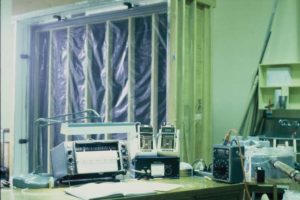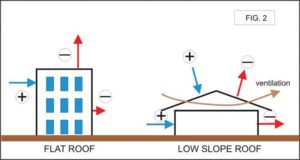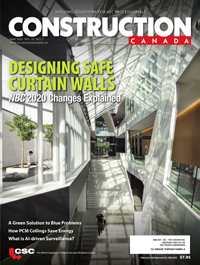Structural Requirements of the Air Barrier Explained

Function 1
The air barrier requires the selection of an assembly of materials that are air impermeable (non-porous and resistant to air leakage), is continuous over the building envelope, or compartmented, and correctly attached to secondary and primary structural components of the building envelope. For example, a metal and glass curtain wall system (shiny glass highrise building) includes a compartmented air barrier (Figure 8, page 30). Equally important, it must be as durable as the structure of the building.
Function 2
The air barrier must be designed to transfer an air pressure load to the secondary and primary structure of the building. Whether a gust of wind or a long-term low-pressure difference from stack effect or ventilation, the pressure difference imposes a structural load (push and suction) on its surface area and its connections within the building envelope. The connections in turn transfer the pressure load further in the exterior wall or roof to the primary structure of the building. If any part of the attachments or support system is weak, poorly fastened, or inadequate for the structural function of the air barrier, the air barrier system will fail before the building construction is completed.
There is a belief (or misconception) a partially completed building envelope wrapped in building paper with all joints taped outside of an insulated layer will perform as an air barrier system. A building paper outboard of the insulated wall is a temporary weather barrier to protect the inner components from rain and/or snow until the remainder of the cladding system is completed. Building papers and other flexible membranes can never support the design wind loads of any building in Canada.
It has not yet been recognized by the construction industry that the air barrier system is as much a structural assembly as a window, a cladding, a roof, a column, or a beam. It must support high pressure loads, both positive and negative, without failing structurally and it must perform the task of controlling air leakage for the life of the building. The air barrier system structure cannot be designed adequately without skill and knowledge of structural design.
This article examines the structural requirements of the air barrier with respect to performance and compliance with the building code requirement 5.3.1.1.(1). It must withstand without fail “…a differential in air pressure due to stack effect, mechanical systems or wind,” and be durable for the service life of the building envelope.
This article is directed to architects and building designers to better understand the performance criteria of the air barrier design and to structural engineers willing to consider the structural challenge in the design of the air barrier system. The structural engineer should offer his services much in the same way they assist the architect to design all types of cladding systems to resist the above stated pressure loads.

Cladding and wall design evolution
Wind, rain and cold were always a challenge to architects and builders. The industry developed better solutions mostly through trial and error. There was very little building science in buildings other than structural design until the early 20th century. Construction techniques were mostly traditional and consensus based. For example Part 9 of the NBCC. Eventually, tradition could not support the necessary design evolution of the building envelope fast enough as rain penetration, condensation and energy saving problems overwhelmed the limited advances by experience and tradition. However, some building science progress found its way into early building envelope design through reasoning for example the face seal method of rain, wind and temperature control.
The cladding is an air barrier
For the longest time, the face sealed cladding of a building provided the primary defense to the elements, wind-driven rain in particular, and air leakage. In older wood framed buildings, two layers of asphaltic black paper were sandwiched between a wood siding and board sheathing. This assembly provided wind driven-rain penetration and air leakage control. More importantly it provided a structural attachment for the wood cladding, building paper, and board sheathing assembly. The wind load was transmitted directly from the siding to the construction paper to the board sheathing to the structural wood frame. This heritage assembly exhibited the characteristics of a structural air barrier assembly by reasoned experience.
In older commercial buildings with stone and brick cladding, the masonry was not vented or drained. Proper pointing of masonry was paramount to its performance. It was often constructed as a multi-layer cladding over an un-insulated exterior wall. This assembly also transmitted the wind load to the primary structure while it provided both rain penetration and air leakage control.







